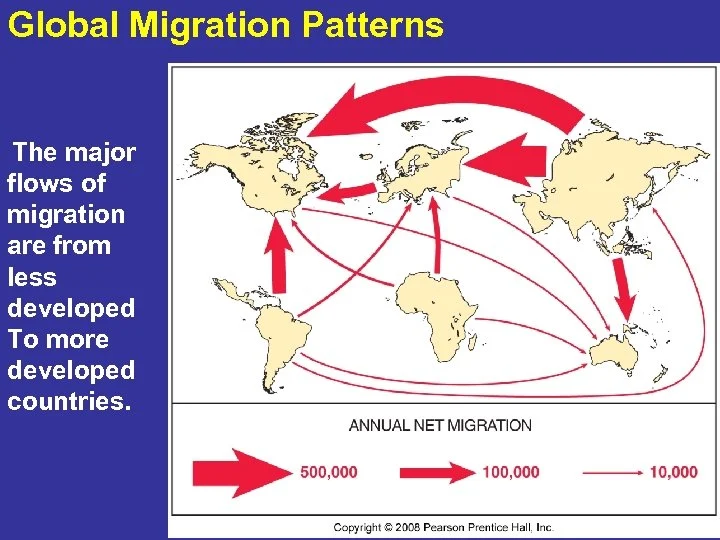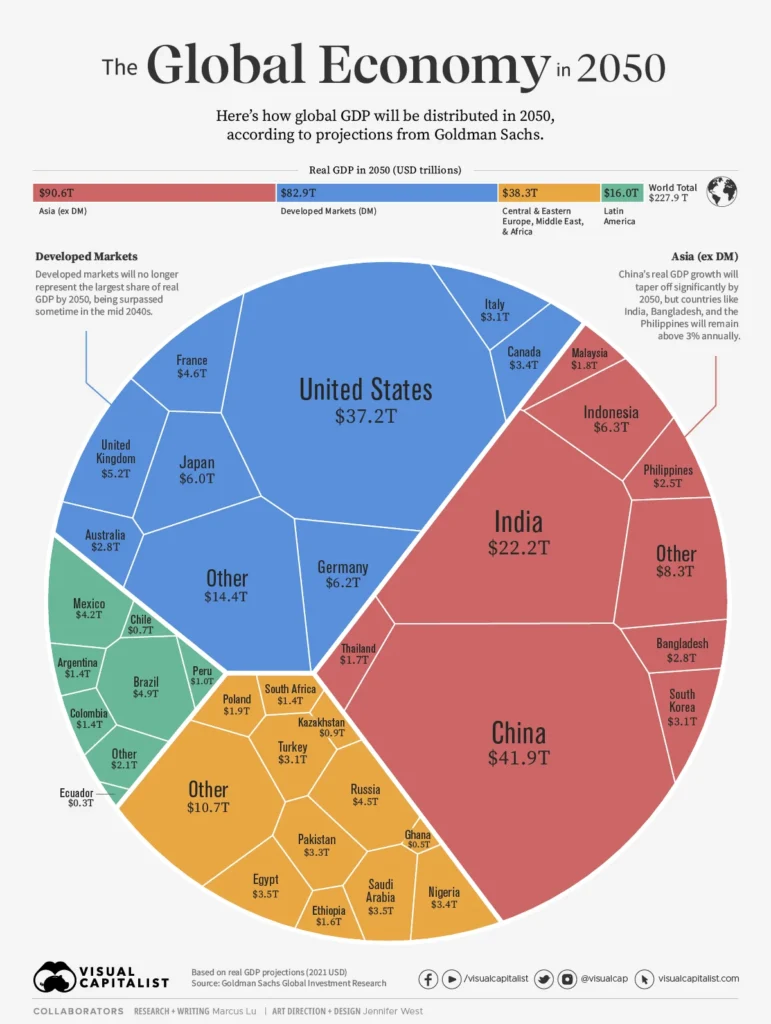Migration patterns, the movement of people from one place to another, have a significant impact on global demographics. The way people migrate, whether it be voluntary or forced, and the reasons behind their movement, such as economic opportunities or fleeing conflict, all contribute to the changing makeup of the world’s population. These migration patterns play a crucial role in shaping the social, cultural, and economic dynamics of different regions and countries, as well as influencing the overall global demographic trends. Understanding and analyzing these patterns is essential for policymakers and researchers in order to address the challenges and opportunities presented by migration and its impact on global demographics.
The movement of people across borders, population redistribution, and the influence of migration on the composition of different societies are all aspects of migration patterns and their impact on global demographics. The dynamics of immigration, emigration, and the resulting changes in population size and structure are also key components of this complex issue. Furthermore, the effects of migration on labor markets, social welfare systems, and political landscapes are important considerations when examining the broader impact of migration patterns on global demographics. The intersection of culture, identity, and diversity is another crucial area of interest when delving into the effects of migration on the demographics of different regions around the world.
1. The History of Migration Patterns
Migration patterns have been a fundamental aspect of human history, shaping the demographics and cultures of regions across the globe. From ancient nomadic tribes to modern-day global migration, people have always been on the move in search of better opportunities, safety, and a higher quality of life. The history of migration patterns is a complex tapestry of push and pull factors, including economic opportunities, political instability, environmental factors, and social dynamics.
Throughout history, migration patterns have played a significant role in shaping the demographics of continents and countries. For example, the transatlantic slave trade resulted in the forced migration of millions of Africans to the Americas, profoundly impacting the demographics and cultural landscape of the regions involved. Understanding the historical context of migration patterns is crucial for comprehending the current global demographic trends and their impact on societies.
2. Global Migration Trends in the Modern Era
In the modern era, global migration patterns have been influenced by a variety of factors, including globalization, technological advancements, and geopolitical changes. Economic opportunities in developed countries, political turmoil in conflict-stricken regions, and environmental challenges such as climate change have all contributed to the current trends in global migration. As a result, there has been a significant increase in the movement of people across borders, leading to the diversification of demographics in many countries.
The modern era has also witnessed the rise of new migration patterns, such as the movement of skilled labor and the phenomenon of brain drain in developing countries. Additionally, the increasing interconnectedness of the world through travel and communication has facilitated the spread of migration patterns, leading to a more diverse and interconnected global population.
3. The Impact of Migration Patterns on Urbanization
Migration patterns have played a crucial role in the process of urbanization, with millions of people moving from rural areas to cities in search of economic opportunities and a better standard of living. This mass movement of people has led to the rapid growth of urban centers and the development of megacities around the world. As a result, urban demographics have been significantly impacted, leading to diverse and multicultural urban populations.
Furthermore, migration patterns have also influenced the urban infrastructure, economy, and social dynamics of cities. The influx of migrants has contributed to the cultural richness of urban areas, leading to the emergence of vibrant and diverse communities. However, it has also posed challenges in terms of housing, healthcare, and social integration, making urban planning and governance crucial in addressing the impact of migration on urban demographics.
4. The Role of Migration Patterns in Shaping Cultural Diversity
Migration patterns have been instrumental in shaping the cultural diversity of societies around the world. As people move from one region to another, they bring with them their traditions, languages, cuisines, and customs, contributing to the rich tapestry of global cultures. This cultural exchange has led to the enrichment and evolution of societies, creating a mosaic of traditions and identities in various regions.
Moreover, migration patterns have also influenced the arts, literature, and music of different cultures, leading to a global exchange of creative expressions. The intermingling of diverse cultural influences has given rise to hybrid forms of art and expression, further enriching the global cultural landscape. Understanding the role of migration patterns in shaping cultural diversity is essential for promoting inclusivity and appreciation of diverse cultures.
5. The Demographic Impact of Forced Migration and Refugees
Forced migration, driven by conflicts, persecution, and environmental disasters, has had a profound demographic impact on regions affected by such crises. The influx of refugees and internally displaced populations has led to demographic changes, placing significant strains on host countries’ resources and infrastructure. The presence of large refugee populations has also posed challenges in terms of social integration and cultural dynamics.
Moreover, the long-term impact of forced migration on the demographics of both the host and origin countries is a complex issue that requires comprehensive solutions. Understanding the demographic impact of forced migration is crucial for developing effective policies and strategies to address the needs of affected populations and promote social cohesion in diverse societies.
6. The Relationship Between Migration Patterns and Aging Populations
Migration patterns have played a significant role in addressing the challenges posed by aging populations in many developed countries. As birth rates decline and life expectancy increases, the proportion of elderly individuals in the population has been on the rise. In response, many countries have turned to immigration as a means to supplement their labor force and support social welfare systems.
Furthermore, migration patterns have also contributed to the diversification of age demographics in many countries, leading to intergenerational interactions and the exchange of knowledge and experiences. Understanding the relationship between migration patterns and aging populations is crucial for addressing the social and economic implications of demographic aging.
7. The Impact of Migration Patterns on Healthcare and Public Services
The influx of migrants in many countries has posed challenges in terms of healthcare services and public infrastructure. The diverse health needs of migrant populations, including language barriers, cultural differences, and access to healthcare, have required healthcare systems to adapt and develop culturally sensitive approaches to service delivery. Additionally, the demand for housing, education, and social services has been impacted by migration patterns, requiring governments to address the needs of diverse populations.
Understanding the impact of migration patterns on healthcare and public services is crucial for developing inclusive and equitable systems that address the needs of diverse demographics. It also requires a comprehensive approach to social integration and the promotion of inclusive policies that cater to the diverse needs of migrant populations.
8. The Environmental Impact of Migration Patterns
Migration patterns are also influenced by environmental factors such as climate change, natural disasters, and environmental degradation. As people are forced to move due to environmental challenges, the demographic impact of such migrations can be significant, leading to changes in population distribution and settlement patterns. Furthermore, the environmental impact of migration patterns extends to the demand for resources, waste management, and urban development.
Understanding the environmental impact of migration patterns is crucial for developing sustainable solutions that address the needs of both migrant populations and the environment. It requires a comprehensive approach to environmental management, urban planning, and resource allocation to ensure the resilience of communities affected by environmental migrations.
9. The Economic Impact of Migration Patterns
Migration patterns have a significant impact on the global economy, influencing labor markets, trade dynamics, and economic development. The movement of skilled labor, remittances sent by migrants to their home countries, and the contribution of migrant entrepreneurs to the economy are all factors that shape the economic impact of migration patterns. Furthermore, migration patterns also influence consumer markets and the demand for goods and services in diverse societies.
Understanding the economic impact of migration patterns is crucial for developing policies and strategies that maximize the benefits of migration for both host and origin countries. It requires a comprehensive approach to labor market dynamics, trade policies, and economic integration to ensure that migration contributes to sustainable economic growth and development.
10. The Future of Migration Patterns and Global Demographics
As the world continues to grapple with complex challenges such as climate change, political instability, and economic disparities, migration patterns are likely to play a crucial role in shaping global demographics in the future. The movement of people across borders, the diversification of societies, and the interconnectivity of global populations will continue to influence demographic trends and cultural dynamics. It is essential to understand the future of migration patterns and their impact on global demographics to develop sustainable and inclusive policies that address the needs of diverse populations.
Furthermore, the role of migration patterns in addressing global challenges such as aging populations, environmental sustainability, and economic development will require comprehensive strategies that promote social cohesion, inclusivity, and equitable opportunities for all. Understanding the future of migration patterns and global demographics is crucial for building resilient and diverse societies that can adapt to the complex dynamics of the 21st century.
| Migration Pattern | Impact on Global Demographics |
|---|---|
| Rural to Urban Migration | Increases urban population, changes in workforce, and demand for infrastructure and services |
| International Migration | Creates diverse multicultural societies, labor force changes, and economic impact |
| Forced Migration (e.g. refugees) | Strain on resources of host countries, social and economic challenges |
| Internal Migration (within a country) | Shifts population distribution, impacts on local economies and services |




